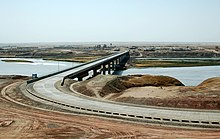Pandji Pojon
|
Pandschi Pojon Панҷи Поён |
||
| Basic data | ||
|---|---|---|
| State : |
|
|
| Province : | Chatlon | |
| District : | Qumsangir | |
| Coordinates : | 37 ° 12 ' N , 68 ° 35' E | |
| Height : | 330 m | |
|
|
||
Pandschi Pojon ( Tajik Панҷи Поён ; formerly Nizhny Pyanj from Russian Нижний Пяндж ) is a village in southwest Tajikistan .
geography
The place is on the right bank of the Punj river , which is about half a kilometer wide and marks the border with Afghanistan . About 25 km southwest of Panji Poyon the river joins the coming from the right Vakhsh the Amu Darya .
Panji Poyon belongs to the district (nohija) Qumsangir the province of Khatlon . It is about 20 km south-southwest of the district administrative seat Dustij , about 75 km as the crow flies south of the provincial capital Qurghonteppa and 150 km south of the state capital Dushanbe .
The Tigrowaja-Balka nature reserve is located a good 10 km west of the village on the lower reaches of the Wachsch .
history
The place received the status of an urban-type settlement on April 29, 1932 , after a narrow-gauge railway had been built from there in 1929 to the Qurghonteppa , which was called Kurgan-Tjube in the Russified era . He was given the name Nizhny Pyandsch, which means the same in Russian as today's Tajik name: "Lower Pandsch", with reference to the location on the river. A village with the Russian name Werchni Pyandsch ("Upper Pyandsch") is located about 16 km northeast (upstream) on a right branch. The settlement also developed slowly due to its location in an agriculturally less usable area - to the north, a semi-desert-like area extends , in contrast to the provincial parts west of the Wachsch and further east around the district center Dustij. It was of certain importance as the location of the border troops of the Soviet Union and as the end point of the narrow-gauge railway, especially after it was extended to Dushanbe, 228 km away, between 1937 and 1941.
The population of the place never exceeded several hundred in the Soviet period: in the 1939 census it was 655, 1959 189 and 1970 (last known value) only 159. On December 26, 1952, Nizhny Pyanj lost the status of an urban-type settlement, However, received it again in 1957 until the 1970s. During this time, the south-west of Tajikistan was opened up by the broad-gauge line from the Uzbek termiz via Qurghonteppa to Jowon , which, however, runs further northwest and left Nizhny Pyanj in a traffic-technical sideline. In the 1980s, passenger traffic on the narrow-gauge railway was gradually discontinued, and after the independence of Tajikistan until the end of the 1990s, the entire network was shut down and dismantled.
The town experienced a new upswing with the construction of the Tajikistan – Afghanistan bridge over the Punj to the Afghan town of Shir Khan Bandar . It opened in August 2007. The construction costs of 37 million US dollars were largely borne by the United States, while the European Union financed the customs facilities on the Afghan side with ten million US dollars. Previously there was only one ferry connection , which could only be used to a limited extent for regional traffic. There was also a new district about 2 km north.
Transport and economy
The European route 123 , which starts in Chelyabinsk, Russia, in the southern Urals , runs through Kazakhstan and Uzbekistan and crosses the western part of Tajikistan from north to south, leads to Pandschi Pojon . Since the bridge was opened, a significant part of the transit traffic from the People's Republic of China via Kyrgyzstan and Tajikistan to Afghanistan has been running on this route . On the Afghan side there is a connection to Imam Sahib , 30 km to the east , the administrative seat of the Imam Sahib district of the same name, and to the provincial capital Kunduz , about 60 km to the south. The road on the Tajik side was expanded by Japanese companies.
From 2008 a special economic zone was established not far from the town and the border crossing, with a counterpart in northern Tajikistan, near Khujand near the border with Uzbekistan.
Web links
Individual evidence
- ↑ Narrow-gauge railway Dushanbe - Kurgan-Tjube - Kuljab, Nizhny Pyandsch on the website of Sergei Bolashenko (Russian)
- ↑ SSSR. Administrativno-territorialʹnoe delenie sojuznych respublik. Janwarʹ 1965 goda. Department for the Work of the Soviets at the Presidium of the Supreme Soviet of the USSR, Moscow, 1965. p. 461 (Russian)
- ↑ Bernd Kuzmits: Borders of orders in Central Asia. Transactions and Attitudes between Afghanistan, Tajikistan and Uzbekistan. (World Regions in Transition, Volume 15) Nomos, Baden-Baden 2013, p. 195
- ↑ a b Christina Nagel: Fight against drug and weapon smuggling. Report by Deutschlandfunk from August 3, 2013.
- ↑ Report by the Tajik news agency Asia-Plus dated December 30, 2008 (Russian)

